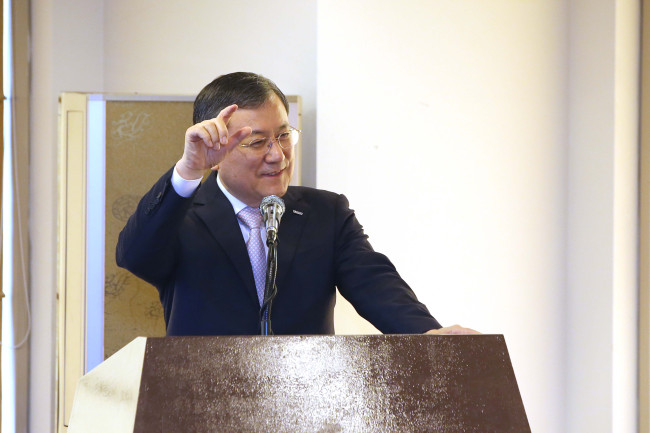KAIST seeks expanded state funding for science, tech leadership vision
Korea’s top science and technology university aims to become one of world’s top 10 universities by 2031
By Sohn Ji-youngPublished : March 13, 2018 - 14:30
South Korea’s top science and technology university KAIST has called on the South Korean government to expand its financial support for the institute, as it seeks to strengthen its research and training programs and help Korea remain competitive in the new age of technology-driven economies.
KAIST on Monday unveiled its “2031 vision” road map, which includes an action plan to innovate its academic training, pave new research areas, encourage more tech-driven entrepreneurship and build a more globalized presence.
In doing so, KAIST hopes to become the first Korean academic institution to be included among the world’s top 10 universities by 2031. The Korean university’s ranking currently hovers at around 41st.
“The execution of our 2031 vision hinges on whether we can secure sufficient resources. Given this, we plan to carefully but aggressively seek expanded funding from now on,” said KAIST President Shin Sung-chul during a press conference in Seoul on Monday.
KAIST on Monday unveiled its “2031 vision” road map, which includes an action plan to innovate its academic training, pave new research areas, encourage more tech-driven entrepreneurship and build a more globalized presence.
In doing so, KAIST hopes to become the first Korean academic institution to be included among the world’s top 10 universities by 2031. The Korean university’s ranking currently hovers at around 41st.
“The execution of our 2031 vision hinges on whether we can secure sufficient resources. Given this, we plan to carefully but aggressively seek expanded funding from now on,” said KAIST President Shin Sung-chul during a press conference in Seoul on Monday.

KAIST is foremost turning to the government to back its efforts. Government financing now accounts for 25 percent of KAIST’s total budget. The university hopes to raise this to 30 percent by 2031, according to Shin.
On top of state funding, KAIST will work to secure additional funds by investing in tech startups founded by its graduates and reaping returns, as well as pooling more donations from its alumni community.
With the new funding, KAIST is seeking to nearly triple its budget from this year’s 859 billion won ($870 million) to 2.03 trillion won in 2031. Without a major budget increase, KAIST will find it increasingly difficult to remain competitive against rival universities in Asia, particularly those in China, Shin said.
Over the past few years, China’s science and technology universities have quickly grown in stature on the back of massive funding from the government, outranking older players like KAIST.
With a growing sense of urgency, KAIST has embraced its 2031 vision, which will seek improvements and innovation on five fronts: education, research, tech-driven entrepreneurship, globalization and future strategizing.
In terms of education, KAIST will focus on nurturing creative leaders. To do so, it will work on diversifying its pool of students, by increasing the percentage of students it accepts from non-science focused high schools by 5 percent annually.
It will also raise the percentage of foreign students accepted into the university from 8.4 percent to 15 percent by 2021, and to 30 percent by 2031.
For undergraduates, KAIST will create interdisciplinary programs that merge multiple areas of studies. It will further offer more online courses teaching new technologies such as artificial intelligence and big data analysis to those already working in the industry.
On the research innovation front, KAIST will push for a collaborative research system in which junior and senior professors pursue joint research in order to ensure that research can be sustained and improved over generations.
Benchmarking the Massachusetts Institute of Technology, the Korean university also plans to raise the number of professors it hires from 676 in 2018 to 1,243 in 2031, with 30 percent of the faculty being non-Koreans.
To better focus its resources, KAIST has also set aside 10 technology research areas to focus on in the next decade. They include hyperphotonics, neural networks for artificial intelligence systems, biotechnology and health care, new energy and next-generation defense technologies, among others.
Encouraging entrepreneurship is another area of focus for KAIST. It plans to expand its ongoing efforts to encourage students to apply their research toward building new, useful products, through establishing larger venture support programs.
There were around 1,456 startups founded by KAIST alumni as of 2018. Together, they created around 32,000 jobs and raised a total of 13.6 trillion won in revenue, according to the university.
On the globalization front, KAIST plans to build an additional global campus in Seoul and another one in an overseas location, forging strategic ties between KAIST’s main Daejeon campus and international locations.
It also will pursue more joint research with other universities abroad, while helping third-world countries build their own science and technology institutes by benchmarking KAIST.
As for its future strategy push, KAIST will open a new think tank dedicated to researching future technology and economic trends. It has already partnered with the World Economic Forum to jointly conduct research on the challenges and changes expected to come from the “fourth industrial revolution.”
Meanwhile, KAIST said it will hold a formal ceremony announcing its new 2031 vision at its main campus in Daejeon on March 20.
By Sohn Ji-young (jys@heraldcorp.com)







![[Graphic News] More Koreans say they plan long-distance trips this year](http://res.heraldm.com/phpwas/restmb_idxmake.php?idx=644&simg=/content/image/2024/04/17/20240417050828_0.gif&u=)
![[KH Explains] Hyundai's full hybrid edge to pay off amid slow transition to pure EVs](http://res.heraldm.com/phpwas/restmb_idxmake.php?idx=644&simg=/content/image/2024/04/18/20240418050645_0.jpg&u=20240419100350)





![[From the Scene] Monks, Buddhists hail return of remains of Buddhas](http://res.heraldm.com/phpwas/restmb_idxmake.php?idx=652&simg=/content/image/2024/04/19/20240419050617_0.jpg&u=20240419175937)

![[KH Explains] Hyundai's full hybrid edge to pay off amid slow transition to pure EVs](http://res.heraldm.com/phpwas/restmb_idxmake.php?idx=652&simg=/content/image/2024/04/18/20240418050645_0.jpg&u=20240419100350)

![[Today’s K-pop] Illit drops debut single remix](http://res.heraldm.com/phpwas/restmb_idxmake.php?idx=642&simg=/content/image/2024/04/19/20240419050612_0.jpg&u=)